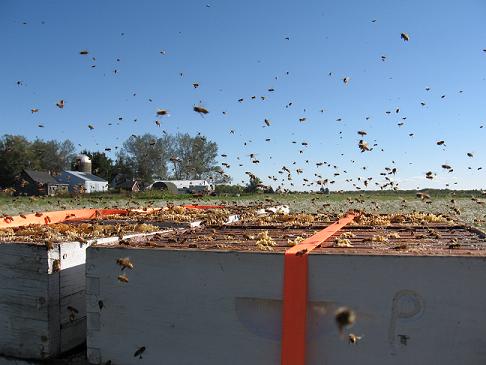Apis mellifera
Nutrition
How do
they get their food? Honey bee colonies rely on their workers to
forage for sustenance, specifically nectar, pollen, and water. When a forager
finds a productive place, she will return to the hive and perform a special
dance by wagging her abdomen and moving in a figure 8 fashion. This is to
communicate the approximate distance and direction relative to the sun, so other
foragers can find the site. Once there the foragers will collect nectar and
pollen to bring back to the hive. The nectar is stored in a special
stomach called the “honey stomach” and the pollen will be carried back on the
corbicula (pollen basket). Nectar and pollen might then be used to feed
larva or get processed into honey for later use.
What do they eat? Honey bees mainly eat nectar, pollen, and honey (a processed form of the nectar and pollen for long term use.) Nectar contains carbohydrates in from organic sugars like glucose and fructose. Pollen also contains various protein, lipids, vitamins, and minerals essential for honey bee growth and development. (Winston,1987) Diet is especially important in honey bees, because it can actually decide what they will develop into. If a larva is fed “Royal Jelly” it may develop into a queen. Royal Jelly consists of a high concentration of mandibular gland secretions, hypopharyngeal gland secretions, and pollen; while normal worker food, contains the same three, but lower concentrations of the secretions. It is these higher concentrations that stimulate a hormone known as Juvenile Hormone. (see Reproduction page for further information) During the winter and early spring, sometimes it is necessary for beekeepers to feed honey bees. Generally they are fed corn syrup and also pollen packets which stimulates colony growth in Spring.
How do
honey bees store their food?
Once the pollen and nectar are collected, they can be turned into honey for long
term use. Honey has special properties antibiotic properties and a high
osmotic pressure, which allows it to exist for long periods of time without
spoiling. The main reason that honey is antibacterial is because of a
reaction with a honey bee enzyme glucose oxidase which produces hydrogen
peroxide. (Seeley, 1985)
Where does
all the food go?
Honey bees have a long esophagus that connects to the crop in the abdomen. When
nutrients are consumed, they travel through the esophagus and are stored in the
crop. Leftover pollen grains travel through the crop to the midgut. This is
where the majority of digestion and absorption take place. (Bailey,1952; Dietz
1969- found in Winston 1987) The waste products are then passed along to the
rectum for excretion.
Do honey bees
have a circulatory system? The honey bee circulatory system is
open meaning that the blood is not contained in any blood vessels. Blood flows
from the aorta and travels around the body bringing nutrients, oxygen, and
removing carbon dioxide and wastes.